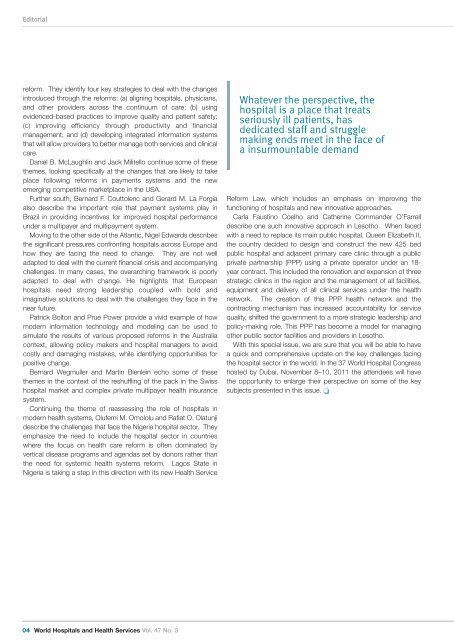World Hospitals and Health Services - International Hospital ...
World Hospitals and Health Services - International Hospital ...
World Hospitals and Health Services - International Hospital ...
Create successful ePaper yourself
Turn your PDF publications into a flip-book with our unique Google optimized e-Paper software.
Editorial<br />
reform. They identify four key strategies to deal with the changes<br />
introduced through the reforms: (a) aligning hospitals, physicians,<br />
<strong>and</strong> other providers across the continuum of care; (b) using<br />
evidenced-based practices to improve quality <strong>and</strong> patient safety;<br />
(c) improving efficiency through productivity <strong>and</strong> financial<br />
management; <strong>and</strong> (d) developing integrated information systems<br />
that will allow providers to better manage both services <strong>and</strong> clinical<br />
care.<br />
Daniel B. McLaughlin <strong>and</strong> Jack Militello continue some of these<br />
themes, looking specifically at the changes that are likely to take<br />
place following reforms in payments systems <strong>and</strong> the new<br />
emerging competitive marketplace in the USA.<br />
Further south, Bernard F. Couttolenc <strong>and</strong> Gerard M. La Forgia<br />
also describe the important role that payment systems play in<br />
Brazil in providing incentives for improved hospital performance<br />
under a multipayer <strong>and</strong> multipayment system.<br />
Moving to the other side of the Atlantic, Nigel Edwards describes<br />
the significant pressures confronting hospitals across Europe <strong>and</strong><br />
how they are facing the need to change. They are not well<br />
adapted to deal with the current financial crisis <strong>and</strong> accompanying<br />
challenges. In many cases, the overarching framework is poorly<br />
adapted to deal with change. He highlights that European<br />
hospitals need strong leadership coupled with bold <strong>and</strong><br />
imaginative solutions to deal with the challenges they face in the<br />
near future.<br />
Patrick Bolton <strong>and</strong> Prue Power provide a vivid example of how<br />
modern information technology <strong>and</strong> modeling can be used to<br />
simulate the results of various proposed reforms in the Australia<br />
context, allowing policy makers <strong>and</strong> hospital managers to avoid<br />
costly <strong>and</strong> damaging mistakes, while identifying opportunities for<br />
positive change.<br />
Bernard Wegmuller <strong>and</strong> Martin Bienlein echo some of these<br />
themes in the context of the reshuffling of the pack in the Swiss<br />
hospital market <strong>and</strong> complex private multipayer health insurance<br />
system.<br />
Continuing the theme of reassessing the role of hospitals in<br />
modern health systems, Olufemi M. Omololu <strong>and</strong> Rafiat O. Olatunji<br />
describe the challenges that face the Nigeria hospital sector. They<br />
emphasize the need to include the hospital sector in countries<br />
where the focus on health care reform is often dominated by<br />
vertical disease programs <strong>and</strong> agendas set by donors rather than<br />
the need for systemic health systems reform. Lagos State in<br />
Nigeria is taking a step in this direction with its new <strong>Health</strong> Service<br />
Whatever the perspective, the<br />
hospital is a place that treats<br />
seriously ill patients, has<br />
dedicated staff <strong>and</strong> struggle<br />
making ends meet in the face of<br />
a insurmountable dem<strong>and</strong><br />
Reform Law, which includes an emphasis on improving the<br />
functioning of hospitals <strong>and</strong> new innovative approaches.<br />
Carla Faustino Coelho <strong>and</strong> Catherine Comm<strong>and</strong>er O’Farrell<br />
describe one such innovative approach in Lesotho. When faced<br />
with a need to replace its main public hospital, Queen Elizabeth II,<br />
the country decided to design <strong>and</strong> construct the new 425 bed<br />
public hospital <strong>and</strong> adjacent primary care clinic through a public<br />
private partnership (PPP) using a private operator under an 18-<br />
year contract. This included the renovation <strong>and</strong> expansion of three<br />
strategic clinics in the region <strong>and</strong> the management of all facilities,<br />
equipment <strong>and</strong> delivery of all clinical services under the health<br />
network. The creation of this PPP health network <strong>and</strong> the<br />
contracting mechanism has increased accountability for service<br />
quality, shifted the government to a more strategic leadership <strong>and</strong><br />
policy-making role. This PPP has become a model for managing<br />
other public sector facilities <strong>and</strong> providers in Lesotho.<br />
With this special issue, we are sure that you will be able to have<br />
a quick <strong>and</strong> comprehensive update on the key challenges facing<br />
the hospital sector in the world. In the 37 <strong>World</strong> <strong>Hospital</strong> Congress<br />
hosted by Dubai, November 8–10, 2011 the attendees will have<br />
the opportunity to enlarge their perspective on some of the key<br />
subjects presented in this issue. ❏<br />
04 <strong>World</strong> <strong><strong>Hospital</strong>s</strong> <strong>and</strong> <strong>Health</strong> <strong>Services</strong> Vol. 47 No. 3
















